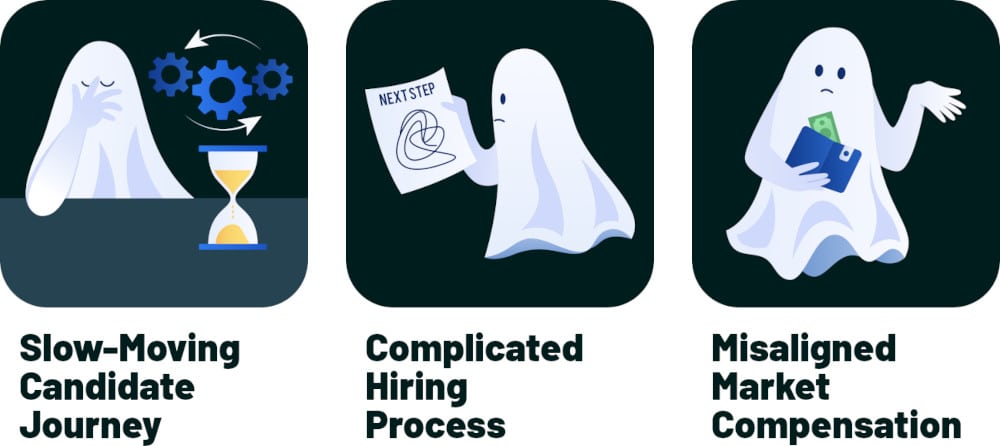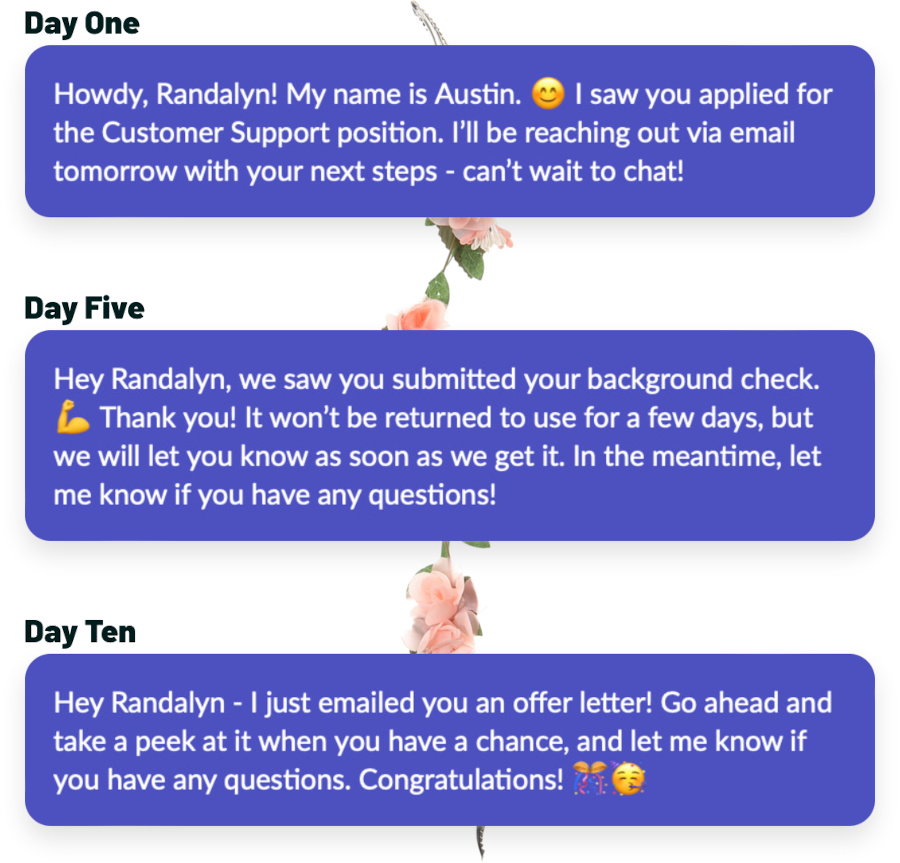The Ultimate Guide to Eliminating Candidate Ghosting
A study by Indeed shows that 57% of employers say candidate ghosting is prevalent, and getting worse. Most of us are jumping this hurdle on a daily basis.
In today’s market, it takes a white-glove experience to engage great candidates. It can feel like an impossible task to think about creating sustainable, scalable processes which prioritize personalization.
When we hire at scale, 43% of our candidates to drop off right after clicking apply. To curb this, we have to think about our processes through a new lens. We are responsible for creating dynamic hiring systems that are simple, efficient, and streamlined.
Candidates have never spooked easier; it’s now mission-critical to create a process that allows applicants a frictionless experience. Friction amplifies ghosting.
If a candidate feels:
- The process is complicated or overwhelming, they are gone
- The experience is poor or impersonal, they will ghost
- Ghosted by you, they won’t hesitate to return the favor
If you’re looking to help your team optimize their time, minimize the amount of candidates that ghost, and enhance your Candidate Net Promoter Score (cNPS), you are in the right place. Let’s dig in. ✨
How Big of a Problem Is Candidate Ghosting?
Most recruiters are currently trying to solve the candidate ghosting dilemma. No matter what roles you’re hiring for, it’s more prevalent than ever before. Thanks to “easy apply,” candidates and businesses alike are stuck playing a numbers game.
“83% of companies face candidate ghosting. The remaining 17% are either misinterpreting their data, or confused by the question. Every recruiter has experienced candidate ghosting more than once.”
Craig de Faselle, Blitz Media
With drop-off rates higher than ever, it’s important to understand the main reasons why candidates are ghosting.
Additionally, candidates are applying to more places than ever – the “spray and pray” method rules today’s hiring climate. Without a reason to remember you, candidates won’t think twice about ghosting you.
More and more, this isn’t limited to the application process. It’s seeping into the next phase of the recruitment process, onboarding. Candidates will sign the offer letter and then ghost before their first day.
Metrics like Time to First Interview, Time in Stage, and Time to Offer are becoming critical measurements. Across the board, you should be exploring ways to lower these.
What Does This Look Like in Practice?
We talked about three of the reasons candidates are admitting to ghosting. In our eyes, they fall in one of two categories.
- Too Much Friction in the Hiring Process
- Life Is Messy and Unpredictable
Now, put yourself in the mindset of a candidate applying to a high-volume hiring position and then getting lost in the application process.
1. Too Much Friction in the Hiring Process
We must acclimate our processes to get applicants from apply to paycheck ASAP. Our friends at Dick’s Sporting Goods believe candidates ghost for three reasons.
You may not be able to change the compensation, but you can create a simple, straightforward process that enables candidates to move quickly.
“Candidates behave like water, they naturally find and gravitate towards the path of least resistance.”
Ty Abernethy, Grayscale
As you think about removing friction from your hiring process, we suggest reflecting on these questions:
- Where am I seeing a significant drop-off?
- Is this a point of friction that I can change?
- What purpose does this step serve in my overall workflow?
The most successful processes allow applicants to move seamlessly at their own pace. The longer your time to hire is, the more likely you are to see a significant amount of applicants dropping off at every stage.
2. Life Is Messy & Unpredictable
I’m sure we could all name a time or two when something in our personal life took over our brains. Maybe we forget to text friends back or drop the ball on some professional responsibilities. We weren’t at our best during these times, but we were trying.
“There are stellar applicants in your pipeline who are struggling with burdens they have no option but to carry.”
Randalyn Hill, Grayscale
Reaching out and throwing them a lifeline can be a thoughtful way to re-engage them. When you reach back out, don’t forget: humans connect best with humans. Bring your warm, empathic personality to the conversation.
We’re seeing organizations successfully rewrite this ghosting narrative when they focus on the personal, human connections their recruiters are making with candidates.
How to Create a Human-Centric Approach to Prevent Candidate Ghosting
When we think about the best hiring experiences, we think about the people we’re hiring! We got to know them, and in turn, both parties developed an excitement for the job and the idea of working together. Now, it’s up to us to replicate that experience at scale.
“You can’t remove the human from human resources.”
Andrew Delabar, Peloton
Recruiters are people people! They want to get to know the candidates, talk with them, learn about them, and build a long-term relationship with them even if they aren’t perfect for this specific job.
At the end of the day, it’s mission-critical to have personal touchpoints. Our customers are changing the ghosting narrative by creating tech-enabled processes to help candidates build a connection with a team member faster.
“Successful hiring teams use technology to enhance the candidate journey, not remove or automate out the human elements.”
Hubert Liu, Grayscale
What You Can Do to Rewrite the Ghosting Story
When it comes to reaching out to ghosted candidates, we see success approaching these candidates with compassion and empathy.
Our knee-jerk reaction when someone ghosts is usually anger or frustration, but those emotions don’t serve to create a deeper connection with our candidates. We challenge you to take an empathetic approach here and always assume positive intent.
1. The Proactive Reminder
Open and frequent communication will keep you top of mind when it comes to staying ahead of the ghosting trend. We all get these reminders about doctors/dentist appointments, and they work! If and when something changes, this open line of communication makes it easier for a candidate to stay in touch and not fall off the radar.
2. The Empathic Reachout
If a candidate ghosts for some reason, it’s easy to let them go and not follow up with them. However, adding an automated reach out to your ATS makes following up seamless and intentional. A kind, thoughtful text will help draw most of your candidates back into the fold!
3. Closing the Loop
When you have an automated drip campaign, you can easily close the loop. When people disappear, this kind of final olive branch will help bring a handful of candidates back or leave those who don’t return with a positive experience.
Using templates like these can help:
- Create open lines of communication between your recruiters and their candidates
- Remove or limit the mixed emotions a candidate may have about accidentally ghosting
- Facilitate professional vulnerability and gives the recruiter an opportunity to better understand and serve the candidate
When you see promising candidates drop off the radar at the last minute, make it a point to follow up with them in a way that stops the shame cycle.
Take a second and imagine it for yourself: you’re moving through a hiring process quickly, and life happens. You miss your interview and feel like you have ruined the opportunity. It’s embarrassing, unprofessional, and disappointing. Now, before you can get too far into that thought spiral, you get a text checking in and asking you if everything is ok. It feels like a breath of fresh air. ☺️
When we’re faced with the option to react harshly or act with intention, we encourage you to create a compassionate plan to follow up with your ghosted applicants.
How You Can Use Tech to Limit Ghosting
Now that you have some ideas on how to follow up with candidates who do ghost, it’s also important to take a proactive approach to the problem. Usually, the most effective approaches involve using all your channels cohesively and respectfully.
When you use multiple channels to connect with a candidate, it helps you stay top of mind. It also gives them more opportunities to experience your personality and form an attachment to the brand.
SMS
In recent years, we’ve seen many businesses incorporate text professionally. Now, it’s easier to reach candidates in the one inbox they manage. So send over that scheduling link, or remind them to check their email, and you’ll see a whole new level of candidate engagement.
This channel leans professional. Usually, emails include important information, like offer letters or scheduling links. Still, not everyone is checking them as frequently as we would like, use sparingly and make sure your email efforts with the company are aligned, so they aren’t overwhelmed by too many communications at once.
If They Have a Reason to Remember You, It’s Harder for Them to Walk Away
One of Blitz Media’s favorite stories is about the recruiter who felt so strongly against using text as a communication channel. By the end of their work together, not only had she started using it, but she was raving about it. By incorporating SMS in her hiring process, she had hired an all-star employee.
“This recruiter started using SMS, bringing her warm personality into reminder texts. A candidate was visiting his mom when he received a reminder text about an upcoming interview. His mom made sure he was seriously considering this company, because it was such an intentional and personal experience.”
Scott de Faselle, Blitz Media
Creating Human-Focused, Tech-Enabled Workflows
We get it. Using more technology to create a human-oriented process seems oxymoronic. So here’s what makes it work: use technology to enable quicker movement through the mundane processes.
“The goal with technology in your candidate journey should be to get them talking with a real human faster, not replacing the human element.”
Ty Abernethy, Grayscale
These use cases could include Assessment Prompts, Scheduling, and Upcoming Event Reminders.
“We use software to automate scheduling, remind candidates about interviews and next steps, so that when we get them in person we can focus on that interaction whole heartedly.”
Rick Jordan, Dick’s Sporting Goods
For DSG, it’s about using tech to increase their interview sit rate. On average, they see a 47% increase in their interview sit rate when they incorporate texting as a means to schedule and remind their candidates.
A lot of our customers cheer their candidates on during the process – scheduling automated, personalized texts after each stage-change.
Final Takeaways on How to Minimize Ghosting
Is candidate ghosting an unsolvable problem? Absolutely not. Does it take some creative solutions to captivate your applicants from start to finish? Absolutely.
Every hiring team has the opportunity to stick out and create an uncommon, memorable experience for their candidates.
The goal should be to rewrite and transform our hiring processes to create personalized touch-points at every step to scale with ease.
No matter what systems you incorporate to create this personalized, white-glove process, be sure to create a human-centric process that treats candidates the way you’d want to be treated.





